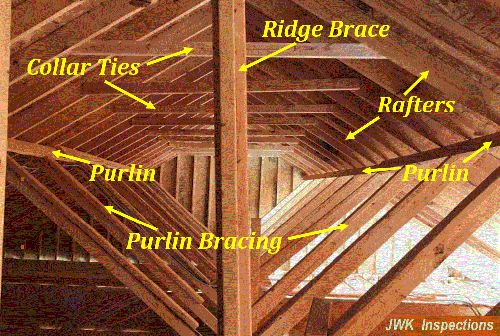

Maybe I just am worrying too much, and maybe if it has been fine for 20 years with plywood in the attic it will be just as fine without plywood. Was the plywood playing much of a role keeping the overlapped floor joists/rafter ties from spreading? Now I’m wondering if I should go back and try to really secure the overlapped 2×10’s together rather than just a few nails – bolts or metal strap? The downwards loads of roof coverings tend to spread the. Since I am not putting the plywood back down due to increased insulation depth, I am wondering if it will create any problems with spreading. Collar Ties are horizontal timber beams between the rafters that stop the rafters spreading. I also added collar ties 1/3 of way down from ridge.

I nailed them to one another with a dozen or so nails where they overlap. I found that the floor joist was not a continuous 2×10 but rather two separate pieces of wood overlapped about 4′ on a load bearing wall, toe-nailed to top plate of bearing wall. I recently pulled up all the plywood, and removed existing fiberglass insulation to blow in cellulose at a greater depth, covering the top of the 2×10 floor joists which I presume act as rafter ties. Looks like when roof was framed they basically decked over the floor of the attic (second floor ceiling) with plywood and then placed the rafters on top of this deck with a birds-mouth cut on edge.
COLLAR TIES VS RAFTER TIES FULL
That tie force still sounds pretty high.Live in Maine have a colonial house with unfinished full attic, 8:12 pitch roof., 20 years old. Also, make sure you check the bending stress in the rafter at the tie point. I think you will need to align the tie with the rafter and use steel side plates with bolts in double shear. I don't believe you can transfer that much load using bolts in single shear. To do that, you need to draw the overlapping joint to scale and plan where the bolts are positioned. Also, you must observe the various end and edge distances for both pieces of wood. The bearing stress in the collar tie is parallel to the grain, but in the rafter it is at an angle to the grain, so you must take the worst case, namely the slope of the grain in the rafter. The capacity of a bolt is determined by the bearing stress on the wood, not by the shear stress in the steel. Comparing 3/4" bolts on the basis of bolt area has no meaning at all. bolt will not come close to resisting 1970#. Trusses, however, incorporate nearly all of these components into a ready-made unit. Rafters are just one component in a roof system, along with collar ties, ceiling joists, rafter ties, strong backs, and weight-bearing walls. If a nail is clinched, it holds much more than one which is not clinched, so I am not sure how you arrived at 107# per nail.Ī 1" dia. Both rafters and trusses can form the framework of a roof system, but they can be used very differently. The capacity of nails varies with the species of wood and the size of nail used. In my low-experience this still seems like over-kill, but numbers don't lie, do they?. ), produces a Lh of 5.2", or 2.6" per bolt which would be achievable in the amount of space provided. Using the above figures and t = 2" (he's using R.S.
COLLAR TIES VS RAFTER TIES SOFTWARE
May I pick your brain a little more? The software now says the collar tie tension is 1970#, and that each end connection needs 13 ea. Az, but in the valley (Phx) its over 100º F. The roof framing mock-up below shows a standard rafter tie. Rafter Ties A rafter tie is a tension tie in the lower third of opposing gable rafters that is intended to resist the outward thrust of the rafter under a load. It's starting to warm up, temps in the 80's up here in the mountains of N. Collar ties, contrary to popular belief, do not prevent walls from spreading. But how would you make sure the joint was allowed to rotate? Put a washer between the Tie and the rafter, with instructions to snug up, but not over-tighten? I'm thinking if I could limit the forces on the Ties to tension only by using a single bolt at each end, thus forming a pinned, or hinged joint, I could design for tension only, and analyze the collar ties the client wants to use. The software says it won't work with the 1.5x7.25 Ties. Learn about roof collar ties, rafter ties, ridge beams, bending moments, tension and compression. The collar ties (& the sheathing) are the only thing holding the structure together. However, in those situations when they are specified, collar ties or ridge straps are usually installed in the upper third of the roof between opposing rafters. Another 2.87 ft vertically downward gets you to the elevation of the top of the walls. From the peak of the ridge vertically downward to the cl of the collar ties is 3.1 ft. The software thinks the collar ties are on every rafter. The rafters are 2x8, 16" oc, and 10.6ft horizontally from cl of ridge beam to inside of wall. My collar tie design software limits the dimensions of my collar ties to 1.5 x 7.25".


 0 kommentar(er)
0 kommentar(er)
